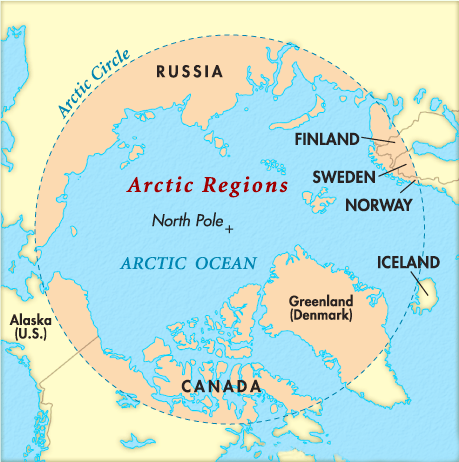Important Facts For Prelims
Arctic Warming
- 15 Feb 2025
- 4 min read
Why in News?
The temperatures at the North Pole (Arctic region) surged more than 20 degrees Celsius above the average temperature, raising concerns about the rapid warming of the region and its global implications.
What are Key Facts About Arctic Warming?
- About: It refers to the rapid increase in temperatures in the Arctic region (area north of 66.5° N latitude), also known as Arctic Amplification.
- Since 1979, the Arctic has warmed four times faster than the global average.
- Causes: A deep low pressure system over Iceland brought warm air from lower latitudes, causing an unusual temperature spike in the Arctic winter.
- Abnormally high North-East Atlantic ocean temperatures intensified warming, with wind patterns carrying extra heat to the Arctic.
- Reduced albedo effect leads to absorption of more heat and raising temperatures.
- The Arctic's weak convection currents trap heat from greenhouse gases near the surface, intensifying warming.
- Potential Consequences: More ice melt could lead to coastal flooding and loss of land.
- Arctic temperature shifts can disrupt jet streams (fast-moving, narrow bands of strong winds in the upper troposphere) impacting global rainfall, storms, and extreme weather.
- Species like polar bears and seals depend on ice for survival, making them vulnerable to habitat loss.
Note: Arctic Circle is an imaginary line located at approximately 66.5° North latitude, marking the southern boundary of the Arctic region.
- It includes parts of Canada, Russia, Greenland, Norway, Sweden, Finland, Iceland, and the United States (Alaska).
India in Arctic Region
- India engaged with the Arctic by signing the Svalbard Treaty in 1920 and launched its Arctic research program in 2007.
- It established the Himadri research base in Svalbard (2008, Norway) and gained Arctic Council observer status in 2013.
- In 2022, India announced its Arctic policy, with the National Centre for Polar and Ocean Research as the nodal agency.
UPSC Civil Services Examination Previous Year Question (PYQ)
Prelims
Q. Which of the following statements is/are correct about the deposits of ‘methane hydrate’? (2019)
- Global warming might trigger the release of methane gas from these deposits.
- Large deposits of ‘methane hydrate’ are found in Arctic Tundra and under the sea floor.
- Methane in the atmosphere oxidizes to carbon dioxide after a decade or two.
Select the correct answer using the code given below.
(a) 1 and 2 only
(b) 2 and 3 only
(c) 1 and 3 only
(d) 1, 2 and 3
Ans: (d)
Q. Consider the following countries: (2014)
- Denmark
- Japan
- Russian Federation
- United Kingdom
- United States of America
Which of the above are the members of the ‘Arctic Council’?
(a) 1, 2 and 3
(b) 2, 3 and 4
(c) 1, 4 and 5
(d) 1, 3 and 5
Ans: (d)





